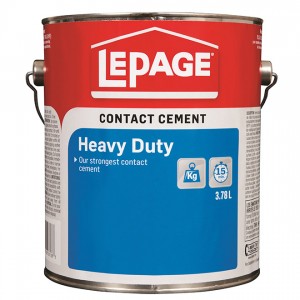Contact Cement
Contact cement is a uniquely useful adhesive as it will adhere to most surfaces. It comes in two basic varieties, solvent based and water based. Water base is often called the “green” or “solvent free” contact cement. Although these two are generally inter- changeable there are some important differences.
changeable there are some important differences.
Water Based Contact cement:
- Gives off no VOCs
- More expensive per ounce
- Higher bonding strength
- Can withstand higher temperatures than solvent based
- Over 80% humidity may cause contact cement to not cure
Solvent Base Contact Cement:
- Strong odor, should be used in well ventilated area
- Less expensive that water based
- Can not be used on foam insulation
- Works better in high humidity environments
- Sticks better than water based to metal and glass.
All Contact Cements can be reactivated by heat. All you need to do is simply warm up the glue with a hot iron, but keep it cool enough not to bother the laminate. This very fact can also be a nuisance of contact cement. The cement can lose its grip when it sits in the sun for a while and warms up, this is why it is rarely used for outdoor projects despite is waterproof nature.
 When applying Contact Cement you must apply it in a thin even coat on both pieces being joined. The joint should be good fitting as the glue line is not thick enough to fill a gap. Depending on the temperature and humidity the surface will become dry but tacky in about 15 minutes. When the glue will not come off on your finger, but it has a tacky feeling, press the two pieces together. Press tightly and it is done — rolling over flexible materials is a good idea. Clamping is generally not necessary.
When applying Contact Cement you must apply it in a thin even coat on both pieces being joined. The joint should be good fitting as the glue line is not thick enough to fill a gap. Depending on the temperature and humidity the surface will become dry but tacky in about 15 minutes. When the glue will not come off on your finger, but it has a tacky feeling, press the two pieces together. Press tightly and it is done — rolling over flexible materials is a good idea. Clamping is generally not necessary.
On very porous surfaces, like the edge of plywood or pressboard, you will notice that the first layer of cement simply disappears into the wood. Always put a primer coat of the same contact cement on these edges first and let them dry a couple of hours. Then apply to both surfaces — now the wood side adhesive no longer just disappears into the wood, in fact the first coat gives it a good grip. If your applying heat applied banding to the edge of plywood or pressboard (that banding heat sensitive adhesive is very similar to contact cement) first put on a primer coat of contact cement and let it dry thoroughly. Then heat apply the tape and the two fuse. Priming the porous surface means that the tape will never come off.